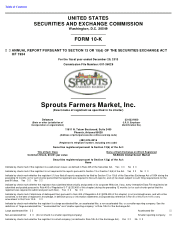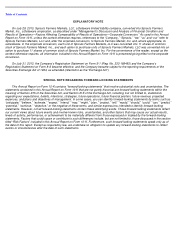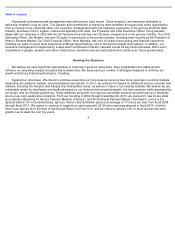Sprouts Farmers Market 2013 Annual Report Download - page 7
Download and view the complete annual report
Please find page 7 of the 2013 Sprouts Farmers Market annual report below. You can navigate through the pages in the report by either clicking on the pages listed below, or by using the keyword search tool below to find specific information within the annual report.
Table of Contents
Our Industry
We operate within the grocery store industry which encompasses store formats ranging from small grocery and convenience
stores to large independent and chain supermarkets. According to the Progressive Grocer , U.S. supermarket sales totaled over
$600 billion in 2012. We believe Sprouts is capturing significant market share from conventional supermarkets and other specialty
concepts in this supermarket segment.
The supermarket segment is comprised of various formats, including conventional, supercenter, natural / gourmet, limited
assortment and warehouse. While the natural and organic food segment is one of the fastest growing segments in the industry,
conventional supermarkets have experienced overall share decline from approximately 73% in 2005 to 67% in 2012, according to
the Progressive Grocer , as customers have migrated to other grocery retail formats. Conventional supermarket customers are
attracted to competitors’ unique product offerings, formats and differentiated shopping experiences.
Sprouts is a high-growth, natural and organic food retailer offering a complete grocery shopping experience, catering to
consumers’ growing interest in living and eating healthier while offering consumers a compelling value relative to conventional
supermarkets and mass retailers. We believe Sprouts will continue to benefit from the following industry and consumer trends:
This overall demand for healthy products is driven by many factors, including increased awareness about the benefits of
eating healthy, a greater focus on preventative health measures, and the rising costs of health care. We believe
customers are attracted to retailers with comprehensive health and wellness product offerings. As a result, food retailers
are offering an increased assortment of fresh, natural and organic foods as well as vitamins and supplements to meet
this demand.
2
• Increasing consumer focus on health and wellness . We believe, based on our industry experience, that consumers are
increasingly focused on health and wellness and are actively seeking healthy foods in order to improve eating habits.
According to the Nutrition Business Journal , sales of natural and organic food have grown at a CAGR of 12.0% from
1997 to 2012, reaching a total market size of $54 billion in the United States and are expected to continue to grow to
$113 billion in 2020, representing a CAGR of 11.3% from 2013 to 2020. In addition, according to the Nutrition Business
Journal , vitamin and supplement sales grew at a CAGR of 5.8% from 1997 to 2012, reaching a total market size of $32
billion in the United States. The Nutrition Business Journal forecasts this market will accelerate growth to a CAGR of
7.1% from 2013 to 2020.
• Emphasis on the customer shopping experience. Consumers are increasingly focused on their shopping experience.
According to the 2011 Food Marketing Institute study, The Food Retailing Industry Speaks , 60% of shoppers do not
shop at the store most convenient to their home. These consumers choose their shopping location based on variety,
price and higher-quality produce and meat. Shoppers are also loyal to their primary store, with 69% of their total grocery
budget spent at their primary store according to a survey in the Food Marketing Institute’s U.S. Grocery Shopper Trends
2012
. Grocers are therefore focused on providing a broad selection of products along with exceptional customer service.
• Consumer desire for value. Customers across formats seek quality products at compelling value. Stores under our
management experienced positive quarterly pro forma comparable store sales growth throughout the recent economic
downturn from 2008 to 2010, while certain traditional, natural and organic retailers faced pressure on sales as customers
shifted to lower-priced items or eliminated certain discretionary purchases. We believe consumers will continue to seek
high-quality, value-priced offerings in their purchases over the long-term, regardless of macroeconomic conditions.




















